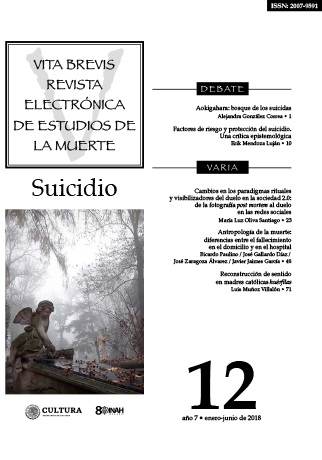Cambios en los paradigmas rituales y visibilizadores del duelo en la sociedad 2.0: de la fotografía post mortem al duelo en las redes sociales
Published 2018-06-30
Keywords
- grief,
- denial,
- society of the positive,
- death,
- social networks
How to Cite
Abstract
New times marked by the absurd philosophy of “the positive,” asepsis, and even the denial of death are part of our cutting-edge culture. Nowadays new cultural and social patterns deprive individuals of feeling death as a natural process of existence, also making death not only something negative and even unnatural, but also a highly lucrative business based on the economic policy of the saving of feelings. In society 2.0, the desire for accompaniment has changed its ways, without completely disappearing. Even though in the late nineteenth and early twentieth century people resorted to post mortem photography as a means of keeping the dead family member alive, today social networks serve to measure in likes or emojis how surrounded subjects feel in their virtual community, making the post mortem portrait something banal and public, in that snapshot that forever leaves death portrayed and at the same time masked.
Downloads
References
- Di Nola, A. M., La negra señora. Antropología de la muerte y del luto, Barcelona, Belacqua, 2006.
- Morin, E., El hombre y la muerte, Barcelona, Kairos, 1974.
- Scheped-huGhes, N., La muerte sin llanto: violencia y vida cotidiana en Brasil, Barcelona, Ariel, 1997.
- ThomAs, Louis-Vincent, T., Antropología de la muerte, México, FCE, 2015.
- Velasco Maíllo, H., Cuerpo y espacio. Símbolos y metáforas, representación y expresividad en las culturas,
- Madrid, Centro de Estudios Ramón Areces, 2007.
- Fuente recuperada de: https://www.xataka.com/medicina-y-salud/el-ultimo-tratamiento-antiedad-cuesta8-000-dolares-usa-sangre-de-personas-jovenes-y-es-puero-humo?utm_source=facebook&utm_medium= social&utm_campaign=botoneraweb.

